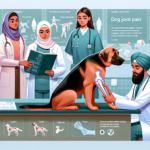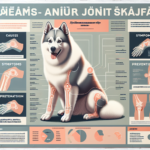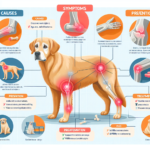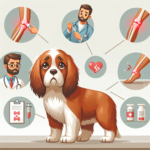Drentsche Patrijshond Joint Pain: Causes, Symptoms, Prevention, and Treatment

Introduction
The Drentsche Patrijshond, often referred to as the Drent, is a versatile and affectionate breed originating from the Netherlands. Known for their hunting prowess, these dogs have been cherished for centuries for their ability to point and retrieve game. With a medium-sized, muscular build, the Drent is not only a skilled hunter but also a loyal family companion. Their friendly and intelligent nature makes them a favorite among dog enthusiasts.
Like many breeds, the Drentsche Patrijshond is prone to certain health issues, with joint pain being a significant concern. Joint health is crucial for maintaining the breed’s active lifestyle and overall well-being. Understanding the causes, symptoms, prevention, and treatment of joint pain in Drentsche Patrijshonds can help owners ensure their dogs lead healthy, pain-free lives.
Breed-Specific Joint Pain Risks
Genetic Predisposition
The Drentsche Patrijshond, like many purebred dogs, has a genetic predisposition to certain joint-related issues. Hip dysplasia, a condition where the hip joint doesn’t fit properly into the hip socket, is relatively common in this breed. Elbow dysplasia, where the elbow joint is malformed, can also occur. Both conditions can lead to arthritis and chronic pain if not addressed early.
Age-Related Risks
As Drentsche Patrijshonds age, the risk of developing joint pain increases. While younger dogs may show few signs of joint issues, older Drents are more susceptible to arthritis and other degenerative joint diseases. Owners should be vigilant as their dogs approach middle age, typically around 5-7 years, and monitor for any signs of discomfort or mobility issues.
Activity Level and Joint Stress
The Drentsche Patrijshond is an active breed, often used for hunting and other high-energy activities. While their athleticism is one of their strengths, it can also contribute to joint stress. Repetitive motions, jumping, and running on hard surfaces can exacerbate joint wear and tear, leading to pain and inflammation over time.
Common Symptoms of Joint Pain in Drentsche Patrijshond
General Symptoms
Owners should be aware of several common symptoms of joint pain in their Drentsche Patrijshond:
- Limping: A noticeable limp or favoring one leg over another can indicate joint pain.
- Stiffness: Difficulty moving, especially after rest, is a common sign of joint issues.
- Reluctance to Move: A dog that is hesitant to jump, run, or climb stairs may be experiencing joint pain.
- Swelling: Visible swelling around the joints can be a sign of inflammation.
- Behavioral Changes: Increased irritability or withdrawal from activities they once enjoyed can indicate discomfort.
Breed-Specific Symptoms
In Drentsche Patrijshonds, joint pain may manifest in specific ways due to their unique build and activity level. Owners might notice a decrease in their dog’s enthusiasm for hunting or playing fetch, activities they typically enjoy. Additionally, the breed’s muscular build may mask early signs of joint pain, making it crucial for owners to pay close attention to subtle changes in behavior and movement.
When to Consult a Vet
If any of the above symptoms are observed, it is essential to consult a veterinarian promptly. Early diagnosis and intervention can significantly improve the quality of life for a dog suffering from joint pain. Regular veterinary check-ups are also crucial for monitoring joint health and catching any issues before they become severe.
Preventive Measures for Joint Health
Exercise Recommendations
Maintaining an appropriate exercise routine is vital for the joint health of a Drentsche Patrijshond. While they require regular physical activity to stay healthy, it’s important to avoid high-impact exercises that can strain their joints. Activities such as swimming, which provides a full-body workout without putting stress on the joints, are ideal. Additionally, moderate walks and controlled play sessions can help keep their joints flexible and strong.
Dietary Suggestions
A balanced diet rich in essential nutrients can support joint health in Drentsche Patrijshonds. Foods high in omega-3 fatty acids, such as fish oil, can reduce inflammation and promote joint lubrication. Supplements like glucosamine and chondroitin are also beneficial for maintaining cartilage health. Consulting with a veterinarian can help determine the best dietary plan and supplements for your dog’s specific needs.
Weight Management
Maintaining a healthy weight is crucial for reducing joint stress in Drentsche Patrijshonds. Excess weight can exacerbate joint pain and lead to more severe issues over time. Owners should monitor their dog’s weight and adjust their diet and exercise routine as needed to prevent obesity. Regular weigh-ins and body condition assessments can help ensure your dog stays within a healthy weight range.
Early Screening and Monitoring
Early screening for joint issues can help catch problems before they become severe. Regular veterinary check-ups should include joint assessments, especially as the dog ages. For breeds like the Drentsche Patrijshond, specific screening tests such as hip and elbow evaluations can provide valuable insights into their joint health. Early intervention can significantly improve outcomes and quality of life.
Treatment Options for Joint Pain
Non-Surgical Treatments
Several non-surgical treatment options can help manage joint pain in Drentsche Patrijshonds:
- Medications: Anti-inflammatory drugs and pain relievers can reduce pain and inflammation.
- Physical Therapy: Specialized exercises and therapies can improve joint function and reduce pain.
- Lifestyle Adjustments: Modifying the dog’s activity level and environment can help manage pain.
Surgical Options
In severe cases, surgical intervention may be necessary to alleviate joint pain. Common surgical options include:
- Hip Replacement: Replacing the damaged hip joint with an artificial one can restore mobility and reduce pain.
- Arthroscopy: A minimally invasive procedure to clean out the joint and remove damaged tissue.
- Joint Fusion: Fusing the joint to eliminate pain from movement, typically used as a last resort.
Alternative Therapies
Alternative therapies can also provide relief for joint pain in Drentsche Patrijshonds:
- Acupuncture: This ancient practice can reduce pain and improve joint function.
- Hydrotherapy: Water-based exercises can strengthen muscles without stressing the joints.
- Massage: Regular massages can improve circulation and reduce muscle tension around the joints.
Lifestyle and Management Tips
Daily Care Routine
A consistent daily care routine can help manage joint pain in Drentsche Patrijshonds. This routine might include gentle exercises, a balanced diet, and regular check-ups with the veterinarian. Incorporating joint-friendly activities like swimming and ensuring the dog gets adequate rest can also be beneficial.
Modifying the Home Environment
Making the home environment more comfortable for a dog with joint pain is essential. Consider the following modifications:
- Ramps: Install ramps to help your dog navigate stairs and get onto furniture without jumping.
- Orthopedic Beds: Provide a supportive bed to reduce pressure on the joints during rest.
- Non-Slip Flooring: Ensure floors are non-slip to prevent falls and further joint injury.
Long-Term Management
Long-term management of joint pain involves a combination of regular veterinary care, appropriate exercise, and a healthy diet. Owners should remain vigilant for any changes in their dog’s condition and adjust their care routine as needed. Consistent monitoring and proactive management can help keep a Drentsche Patrijshond active and happy despite joint pain.
FAQs About Drentsche Patrijshond and Joint Pain
What are the early signs of joint pain in Drentsche Patrijshonds?
Early signs include limping, stiffness, reluctance to move, and behavioral changes such as irritability or withdrawal from activities.
Can joint pain in Drentsche Patrijshonds be prevented?
While genetic predispositions cannot be entirely prevented, maintaining a healthy weight, providing appropriate exercise, and regular veterinary check-ups can significantly reduce the risk and severity of joint pain.
Are there specific diets that can help with joint health?
Yes, diets rich in omega-3 fatty acids, glucosamine, and chondroitin can support joint health. Consult with a veterinarian for specific dietary recommendations.
When should I consider surgery for my dog’s joint pain?
Surgery should be considered when non-surgical treatments are no longer effective, and the dog’s quality of life is significantly impacted. A veterinarian can provide guidance on the best course of action.
What alternative therapies are effective for joint pain in Drentsche Patrijshonds?
Alternative therapies such as acupuncture, hydrotherapy, and massage can provide relief and improve joint function. These should be used in conjunction with traditional treatments for the best results.
Conclusion
Joint pain is a significant concern for Drentsche Patrijshonds, but with proper care and attention, it can be managed effectively. Understanding the causes, symptoms, prevention, and treatment options is crucial for maintaining your dog’s joint health. Regular veterinary check-ups, a balanced diet, appropriate exercise, and a supportive home environment can help ensure your Drentsche Patrijshond leads a happy, active life. By taking proactive measures and consulting with your veterinarian, you can provide the best care for your beloved companion.




